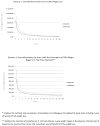Comparing behavioral weight loss modalities: incremental cost-effectiveness of an internet-based versus an in-person condition
- PMID: 21253001
- PMCID: PMC3137759
- DOI: 10.1038/oby.2010.341
Comparing behavioral weight loss modalities: incremental cost-effectiveness of an internet-based versus an in-person condition
Abstract
The objective of this study was to assess the costs associated with a group behavioral weight loss intervention and compare cost-effectiveness based on treatment delivery modality (in-person vs. Internet). A randomized controlled trial examined efficacy of a group behavioral obesity intervention across in-person and Internet treatment modalities. Participants (N = 323, 93% women, mean BMI = 35.8) from two centers were randomized to treatment modality, and contact time was matched between conditions. Primary outcome was weight loss. Cost-effectiveness measures calculated life years gained (LYG) from changes in weight at 6 months, based on excess years of life lost (YLL) algorithm and the cost of the two modalities. In-person participants had significantly greater weight losses (-8.0 ± 6.1 kg) than Internet participants (-5.5 ± 5.6 kg), whereas differences in LYG were insignificant. Estimated LYG was 0.58 (95% confidence interval: 0.45, 0.71) and 0.47 (95% confidence interval: 0.34, 0.60) for the in-person and Internet condition, respectively. Total cost of conducting the in-person condition was $706 per person and the Internet condition was $372 per person with the difference mainly due to increased travel cost of $158 per person. The incremental cost-effectiveness ratio was $2,160 per (discounted) LYG for the Internet modality relative to no intervention/no weight loss and $7,177 per (discounted) LYG for the in-person modality relative to the Internet modality. Participant time costs are recognized as an important cost of medical and behavioral interventions. When participant time costs are included in an economic evaluation of a behavioral weight loss intervention, Internet-based weight loss delivery may be a more cost-effective approach to obesity treatment.
Conflict of interest statement
None of the authors have conflicts of interest to report.
References
-
- Ogden CL, Carroll MD, Curtin LR, McDowell MA, Tabak CJ, Flegal KM. Prevalence of overweight and obesity in the United States. J Am Med Assoc. 2006;295(13):1549–55. - PubMed
-
- Bray GA. Medical consequences of obesity. J Clin Epidemiol Metab. 2004;89(6):2583–9. - PubMed
-
- Wang Y, Beydoun M, Liang L, Caballero B, Kumanyika S. Will all Americans become overweight or obese? Estimating the progression and cost of the US obesity epidemic. Obesity. 2008;16:23–30. - PubMed


